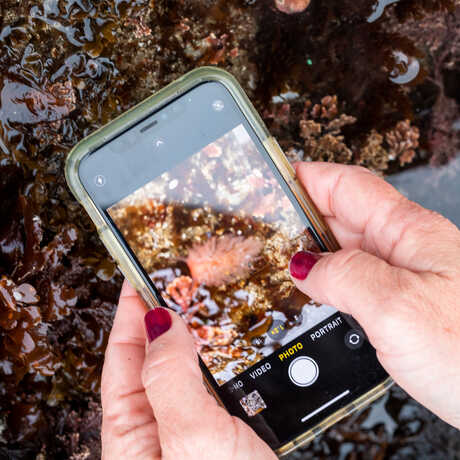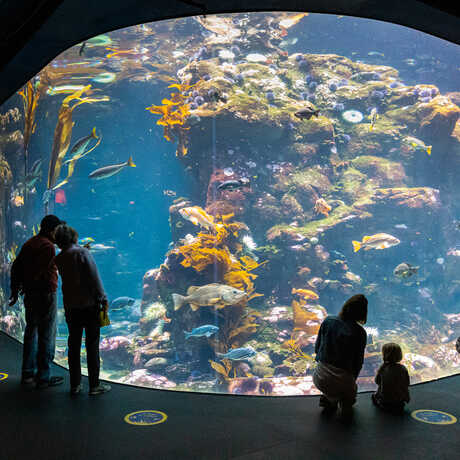
Vibrant sea slugs. Giant green sea anemones. Iridescent algae. California tidepool flora and fauna exhibit a dazzling array of colors, body shapes, and adaptations that help them thrive in the harsh conditions at the ocean’s edge. With a little planning (and some good footwear) you can visit these stunning habitats and get an up-close look at some of nature’s mini-masterpieces.
Table of contents:
What are tidepools?
Tidepools are the pools of seawater that are left behind when the tide goes out. The areas around tidepools that are submerged at high tide and exposed at low tide are called the intertidal zone. These habitats are full of diverse marine life which can be observed at low tide by simply walking on and around the rocks—no wetsuit needed!
Because they are relatively accessible without specialized equipment, tidepools are a great place to observe a variety of colorful and interesting marine animals and seaweeds in California.
Where can I find them?
Tidepools and intertidal zones can be found on any stretch of rocky coastline around the world, but some are much easier to access than others, especially if you are new to tidepooling.
Below is a non-exhaustive list of California tidepool sites that are more easily accessible for beginners. These sites are located within federal, state, and local parks that have visitor centers, docents, and resources to help you explore safely. Please note that each site will have different regulations around group sizes and the touching and handling of organisms, especially if it is part of a marine protected area (MPA). Always check park guidelines before your visit, especially if you are planning to bring a larger group.
Northern California
San Francisco Bay Area
Central Coast
Southern California
When should I go?
Tidepools are only accessible at low tide. (At high tide, they’re underwater!) In general, you want to find a low tide that happens during daylight hours and is less than 0.5 feet—but the lower the tide the better. Plan your next tidepooling adventure with our Tide Finder web app where you can search for daytime low tides near you.
What should I bring?
Clothing: Wear comfortable layers! California coastal weather can change quickly—it can be cold and windy one moment and sunny the next. Hats and sunglasses are always a good idea, as is a backpack or fanny pack so you can keep your hands free.
Footwear: Waterproof rubber boots are the best choice and will allow you to navigate the tidepools with ease. Other sturdy shoes with good tread that you don’t mind getting wet will also work. Definitely no flip-flops—they are much too slippery!
Tech: Bring your smartphone (preferably with a waterproof case) with the iNaturalist app installed. This will help you identify the animals and seaweeds you see and allow you to log your observations and contribute to our understanding of how species are changing over time.
Optional: Some tidepoolers bring hiking poles for greater stability and balance on uneven, rocky areas. Water, sunscreen, and snacks will help you stay comfortable. A headlamp or flashlight is handy for looking inside rock crevices or if you are heading back from the tidepools after sunset. You can also bring field guides to help you identify species.
What will I see?
How do I tidepool safely?
Watch your step: Tidepooling often involves navigating rocky surfaces that can be uneven and slippery. Plan your steps carefully, and note that seaweed can be extra slick. Getting up close to look for animals in tidepools and rock crevices may involve some bending and crouching over. Keep your center of gravity low, and consider using a hiking pole or walking stick to help keep your balance.
Slow down: You don’t have to go fast or far to observe plenty of cool marine biodiversity. Generally, the slower you go, the more you’ll notice—and the more rewarding the experience will be. You should always move at a pace that feels comfortable to you, regardless of what other tidepoolers are doing.
Be wave wise: Never turn your back on the ocean. Tidepools exist in a dynamic, unpredictable coastal environment: A series of smaller waves can be followed by a bigger one, and surprise “sneaker” waves can appear suddenly. Don’t get caught unaware!
Tidepool together: As with most other outdoor activities, it is always safer to tidepool with others. If you are going out alone, be sure that someone knows where you are and when you expect to be back.
How do I tidepool respectfully?

Observe things where you find them: Never remove animals, rocks, shells, seaweeds, or plants from the tidepools. Do not “roll” rocks. Animals living on the underside of rocks can only survive there.
Walk gently: Take care to avoid stepping on animals or seaweeds as much as possible. Try to stay on bare rock, but if you need to cross an area with living animals (e.g., a mussel bed or barnacles), put your foot down slowly and squarely and avoid any scuffing or twisting motions.
Respect Indigenous stewardship and co-management of tidepools and coastal areas: Tidepools are important cultural and harvesting sites for Native communities in California. Tribes have stewarded the coast for centuries and continue to do so today through the Tribal Marine Stewardship Network.
Be aware of the rules and regulations for collecting or fishing at your site: In general, a California fishing license is required for any fishing or harvesting of animals or seaweed. If your tidepool site is within a protected area such as a State Marine Conservation Area (SMCA) or State Marine Reserve (SMR), removal of any tidepool organism may be prohibited.
What if I can't physically visit?
Tidepools are not always accessible to everyone. Luckily, there are several aquariums and science centers throughout California with touch tank exhibits that allow visitors to get up close to tidepool species.
Below is a non-exhaustive list of attractions and facilities with touch tanks. Please check the location’s website for the most up-to-date information and for any specific access needs.
San Francisco Bay Area
- Aquarium of the Bay (San Francisco)
- Environmental Discovery Center at Spring Lake Regional Park (Santa Rosa)
- Bodega Marine Lab (Bodega Bay)
Central California
- Seymour Marine Discovery Center (Santa Cruz)
- Santa Cruz Museum of Natural History (Santa Cruz)
- Monterey Bay Aquarium (Monterey)
Southern California
- Sea Center, Santa Barbara Museum of Natural History (Santa Barbara)
- Heal the Bay Aquarium (Santa Monica)
- Birch Aquarium (La Jolla)
You can also learn about tidepool species while contributing to community science by helping to identify species for California tidepool projects on iNaturalist!
How can I learn more and share my observations?
Using the iNaturalist or Seek app on your smartphone is one of the best ways to identify and share the species you see. These apps use a computer vision model to automatically identify the species in your photos. Other members of the iNaturalist community can also add or verify identifications of your observations.
You can learn a lot from other tidepoolers if you join a bioblitz during Snapshot Cal Coast every summer or Solstice Sea Star Search every December. You can also find tidepooling resources from visitor centers and docents in some state and county parks.
Learn more now by watching this talk featuring the co-directors of the Center for Biodiversity and Community Science, Rebecca Johnson and Alison Young.
The Academy's Center for Biodiversity and Community Science connects people to nature and to each other through the collection of biodiversity data for science and management.















